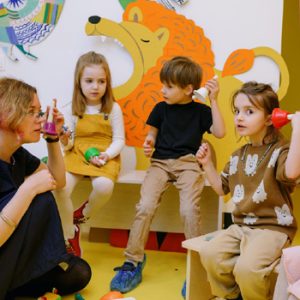Discovering Finland’s Education System: Top 10 Reasons Why It’s the Best in the World.
Finland has been recognized as having one of the world’s best education systems due to several factors. Firstly, the Finnish government invests heavily in education, allocating a significant portion of its budget towards schools and education initiatives. Secondly, the Finnish education system is highly equitable, providing free education to all students, regardless of their socio-economic background.
Another important factor is that Finnish teachers are highly educated and respected professionals. They are required to have a Master’s degree and are given significant autonomy in their classrooms to develop their teaching practices. Additionally, teachers in Finland are not evaluated based on student performance on standardized tests but rather on their overall classroom practices and student well-being.
The Finnish education system also emphasizes play-based learning and hands-on activities, which have been shown to be effective in promoting student engagement and creativity. The curriculum is designed to foster critical thinking and problem-solving skills, rather than just rote memorization.

Moreover, Finland has a strong focus on student well-being and mental health, with an emphasis on reducing stress and anxiety in students. This includes offering students access to health services and providing ample time for outdoor activities and breaks during the school day.
Discover Why Finland’s Education System Dominates the World and America: 10 Reasons Finland’s education system surpasses the world and America, and it’s not because they’re cramming in dimly-lit rooms on robotic schedules or stressing over standardized tests enforced by the government. Finland’s education success comes from implementing common-sense practices and a holistic teaching environment focused on equity rather than excellence. Check out the top 10 reasons why Finland’s education system is dominating the global stage.in producing well-educated students and a highly skilled workforce.
- Why Finland’s Education System Thrives Without Standardized Testing Unlike the traditional approach of filling in bubbles on a scantron, Finland’s education system prioritizes personalized learning and subject comprehension. In contrast to the pressure to teach to the test and cramming, students in Finland are assessed by their teacher based on an individualized grading system, without standardized tests except for a voluntary National Matriculation Exam at the end of upper-secondary school. The Ministry of Education monitors overall progress by sampling groups from different schools, allowing for a holistic evaluation of student success. Learn how Finland’s lack of standardized testing contributes to their thriving education system.
- Why Finland’s Education System Succeeds: Accountability and Rigorous Standards for Teachers The Finnish education system has raised the bar for teachers so high that there is often no need for a strict “grading” system to hold them accountable. Pasi Sahlberg, director of the Finnish Ministry of Education and author of Finnish Lessons: What Can the World Learn from Educational Change in Finland?, highlights the importance of responsibility over accountability in the Finnish approach to education. With rigorous and selective teaching programs, all teachers in Finland are required to hold a master’s degree before entering the profession. Instead of relying on bureaucratic checks and standardized testing, individual principals are responsible for ensuring their teachers are performing at their best. Learn how Finland’s unique approach to the pupil-teacher dynamic has led to their education system’s unparalleled success.
- How Finland’s Education System Succeeds with Cooperation, Not Competition Finland’s education system differs from other countries that view it as a fierce Darwinian competition. Instead, they prioritize cooperation over competition, which has propelled them to the forefront of the international education scene. Finland doesn’t rely on artificial or arbitrary merit-based systems or top-performing school lists. Rather than a cutthroat environment, cooperation is the norm. Discover how Finland’s educational philosophy of cooperation is paying off.
- Prioritize the Basics: Creating a Happy and Healthy Learning Environment. In their pursuit to improve test scores and comprehension in subjects like math and science, many schools overlook the importance of ensuring a positive and supportive environment for their students. However, the Finnish school system serves as an excellent example of how focusing on the basics can lead to happier, more harmonious, and healthier students. Years ago, Finland recognized the need for significant educational reforms. Rather than emphasizing exceptional grades or increased competition, they prioritized creating a more equitable school environment.
Since the 1980s, Finnish educators have prioritized the following basics:
- Using education as a tool to combat social inequality
- Providing free school meals to all students
- Ensuring easy access to healthcare
- Offering psychological counseling services
- Providing individualized guidance and support
By placing a strong emphasis on equality within a collective environment, Finland has successfully created a student-centered approach to education.
- Beginning Education at an Older Age in Finland: Giving Children the Freedom to be Kids In Finland, students start school at the age of seven, allowing them to enjoy their developing childhood years without being burdened by compulsory education. Unlike many other countries, Finnish children are only required to attend 9 years of compulsory school. Beyond this, education is optional after the ninth grade or at the age of 16. This approach not only allows children to enjoy their childhood but also promotes a sense of psychological freedom. Many students feel trapped by the rigid requirements of traditional education, but Finland takes a different approach by preparing children for the real world while also allowing them to experience the joys of childhood.
- Exploring Alternative Professional Pathways Beyond Traditional College Degrees. The American education system’s traditional pipeline from K-12 to college has become stagnant and unyielding. For many students, college can result in a worthless degree, a sense of purposelessness, and massive debt. However, Finland has found a solution to this dilemma by offering equally viable options for students to continue their education and build a fulfilling career. Rather than a focus on the college-educated versus the working class, Finland offers two paths: Upper Secondary School and vocational education. The Upper Secondary School is a three-year program that prepares students for the Matriculation Test, which determines their eligibility for university based on the specialties they’ve acquired during their time in high school. On the other hand, vocational education is a three-year program that provides students with training for various careers. They have the option to take the Matriculation Test and apply to university if they choose to do so. By providing these alternative pathways, Finland recognizes that both college and vocational education can lead to equally professional and fulfilling careers
- Sleep-Friendly School Days: Finns Start Later for a More Balanced Education. Early morning routines, long commutes, and extracurricular activities can leave students feeling drained and unmotivated. With some classes starting as early as 6 am or 8 am, it’s no wonder that many adolescents struggle to stay alert during the day. In Finland, however, students typically start school between 9:00-9:45 am, a schedule that research shows promotes better well-being, health, and maturation. Finnish schools prioritize a balanced education, with longer class periods and extended breaks throughout the day. The focus is not on cramming information into students but on creating a holistic learning environment that fosters intellectual and personal growth. By starting later and offering more restful mornings, Finnish schools are helping students to achieve success and wellness in equal measure.
- Benefits of Consistent Instruction from the Same Teachers in Finnish Schools. In Finnish schools, there is a lower student-to-teacher ratio. This means that teachers are able to provide individualized attention and instruction to each student, which can be difficult in large classes. In fact, students in Finland often have the same teacher for up to six years of their education. This continuity allows for a unique bond to form between teacher and student, similar to that of a mentor or family member. During these years, mutual trust and respect can develop, leading to more effective learning. Each student has their own unique needs and learning style, and Finnish teachers are adept at identifying and accommodating these differences. With consistent instruction from the same teacher, they can accurately track and monitor each student’s progress, offering personalized guidance and support to help them reach their goals. This also eliminates the need to pass students along to a new teacher every year.
- Creating a Relaxed Learning Environment: The Finnish Approach. Finland’s educational system stands out for its emphasis on reducing stress and fostering a more caring atmosphere for both students and teachers. Rather than subjecting students to unnecessary regimentation, Finnish schools promote a more relaxed environment with fewer classes per day and ample time for recreational activities and relaxation. Throughout the day, students enjoy 15 to 20-minute breaks to stretch, breathe fresh air, and decompress. This approach also extends to teachers who have access to lounges throughout Finnish schools where they can relax, prepare for the day, or socialize with colleagues. Teachers are essential to the learning environment and need to be functional, well-rested, and at their best to perform their duties effectively.
- Revolutionary Education System: Less Homework and Outside Work for Finnish Students. The Finnish education system is making waves globally, and for a good reason. According to the OECD, Finnish students have the least amount of outside work and homework than any other student in the world. They spend a mere half an hour a night working on school-related tasks, without the added stress of tutors and extracurricular pressures. Remarkably, Finnish students are outperforming cultures that place excessive school-to-life balances on their students. By reducing the unneeded stress of grades and busy-work, Finnish students can focus on the true purpose of education: learning and growing as individuals. By providing a revolutionary education system with fewer academic demands outside of school, Finland is redefining what it means to be successful in the classroom and beyond.
By: Mr. WWK









